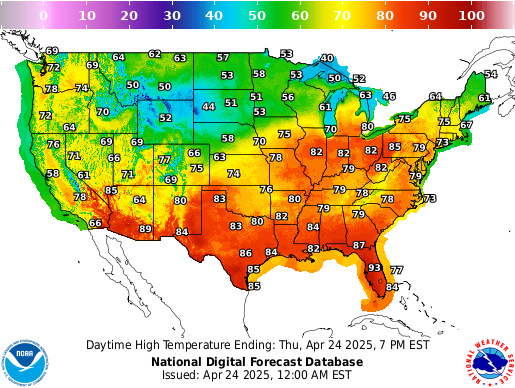Temperatures Near Cumberland Center, Maine from Four Volunteer Meteorological Stations
Data provided graciously by https://weather.gladstonefamily.net
and the Citizen Weather Observer
Program. Also the NOAA National Weather Service.

Other National maps. This one is Interactive
The source code for collecting data and generating charts is available on request. Charts are refreshed nightly.

Figure 1. Weekly air temperatures for the previous 12 weeks at the four observation stations.
In all charts, Max Data is the latest measurement from the database. This Week, or this whatever time period, is the date the chart was generated.
Variance between the two indicates that either data for the current day is not available in the database for some reason (if This Week is later than Max Data) or someone went back in time and ran the chart scripts before the data were loaded (if This Week is earlier than Max Data).

Figure 2. Yearly comparison of weekly average air temperatures at station e4229

Figure 3b. Comparison of a few years of temps for the last 30 days of daily temps for station E1248

Figure 3d. KPWM Daily temperature and electricity for the last 60 days
Updated cost per khw from .18 to .25 on April 4, 2023

Figure 3d. Monthly gas and electricity use

Figure 3e. Monthly gas and electricity cost in dollars

Figure 3e. Monthly electricity cost versus use correlation plot

Figure 3f. Monthly electricity cost

Figure 3g. Weekly electricity use against average temperature at E1248 before the year 2020

Figure 3h. Weekly electricity use against weekly cumulative Heating Degree Days (HDD) using the 65 degree point at E1248 before the year 2020
From weather.gov
Degree days are based on the assumption that when the outside
temperature is 65°F, we don't need heating or cooling to be comfortable.
Degree days are the difference
between the daily temperature mean,
(high temperature plus low temperature divided by two) and 65°F. If the temperature mean is above 65°F, we
subtract 65 from the mean and
the result is Cooling Degree Days. If the temperature mean is below 65°F, we subtract the mean from 65 and the
result is Heating Degree Days.
days occur in the summer and occasionally in the fall

Figure 3i. Weekly electricity use against average temperature at E1248 for the year 2020 and after

Figure 3j. Weekly electricity use against weekly cumulative Heating Degree Days (HDD) using the 65 degree point at E1248 for the year 2020 and after

Figure 3k. Annual energy costs by year. Also showing therms of heat applied through gas as normalizer for use.

Figure 4. Yearly comparison of weekly average air temperatures at station e4279

Figure 5. Yearly comparison of weekly average air temperatures at station KPWM

Figure 6. Overview map displaying the relative positions of the monitoring stations and the home base. Static map developed with Qgis
Two different elevations for each station are shown in the table. Elevations from the US National Elevation Dataset appear to be the most accurate.

Figure 7. Monthly electricity costs for each kwh used as a scatter plot.
The entire electric bill is used to calculate cost. Therefore if the delivery costs go up, but the commodity (cost of each kwh from the supplier) stays the same, the apparent cost to deliver the electricity will still rise. This shows any possible relation between khws used and the cost per kwh.
Colors highlight the drift upward over time.

Figure 8. Monthly electricity dollars (cents) for each kwh over time.
The entire electric bill is used to calculate cost. Therefore if the delivery costs go up, but the commodity (cost of each kwh from the supplier) stays the same, the apparent cost to deliver the electricity will still rise.
This should show a rise over time of cost per kwh as delivered to the house, which incorporates both commodity as well as infrastructure/business cost changes.
Figure 7. Interactive map provided by Mapbox.com
Figure 8. Plumbing. This is how this site is maintained.
- Data is stored in a Maria DB database (fomerly MySQL) with a ton of views for easy data extraction and concise, centralized aggregation.
- Data shuffling logic is done with BASH shell scripts and the presentation (charts) is performed with matplotlib glued to the database through sqlalchemy, pandas, and numpy -- all Python libraries.
- Data operations all run on a Raspberry Pi 3B in the basement. The page and image you see are all static from a shared host and are updated nightly by jobs from the Pi.

Figure 9. A naked Raspberry Pi 3B

Figure 10. The Pi in action. USB-powered and connected over WiFi.
Page Last modified: March 2, 2023



